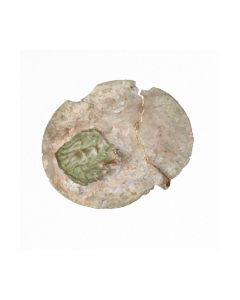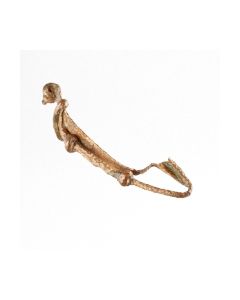Search results for: 'fibula'
-
 Celtic fibula
Celtic fibulaRare fibula from the La Tène culture with beautiful enamel inlays. The main material is well preserved for an iron fibula.
Price: on request Gallo-Roman animal fibula
Gallo-Roman animal fibulaZoomorphe Fibel mit Wildtier als Motiv. Schmuckstück mit religiöser Symbolik, vergleichbar einem Kreuzanhänger bei heutigen Christen. Gefertigt im 1. bis 3. Jh. n. Chr. in Gallien.
Price: on request Enameled Galo-Roman fibula
Enameled Galo-Roman fibulaGrundform einer rechteckigen Platte, erweitert durch Zierknopf an Kopf- und Fußende. Drei Paare von Dreiecken auf der Platte sind durch weiße Einlagen hervorgehoben. Etwa 2. Jh. n. Chr.
Price: on request Rare discus-shaped Celtic-Roman fibula
Rare discus-shaped Celtic-Roman fibulaAus der Entstehungszeit der plattenförmigen Fibeln, 1. Jh. n. Chr. Ästhetisch ansprechende Metallarbeit aus einer Fusion keltischer Handwerkstraditionen mit römischen Vorlieben.
Price: on request Roman sandal sole type fibula
Roman sandal sole type fibulaDie Form wird in der Literatur als Schuh- oder Sandalensohle bezeichnet. Der sehr dekorative Fibeltyp war extrem beliebt und im zweiten Jahrhundert weit verbreitet. Er stammt aus den nördlichen römischen Provinzen.
Price: on request Published Roman fibula with celtic design
Published Roman fibula with celtic designAncient fibula from the Roman province of Britain. The design can be attributed to the celtic tribe of the Trinovantes or Iceni. From the famous Hattatt collection. Published twice.
Price: on request Ancient fibula from the Hattatt collection
Ancient fibula from the Hattatt collectionAncient fibula of the rare adlocutio type. Repoussé work of a scene from a Roman sestertius of Hadrian in celtic style. Find from Dorset in Roman Britain. Published in Hattatts famous book series on ancient fibulae.
Price: on request Celtic fibula from the famous Hattatt collection
Celtic fibula from the famous Hattatt collectionFibula from the La Tène II period. Found in Celtic Carnuntum. The piece is published in the standard work "Iron Age and Roman Brooches".
Price: on request Roman discus fibula with color glass paste
Roman discus fibula with color glass pasteSpannende Fibel mit Sterndekor und Glaspaste. Eine Weiterentwicklung keltischen Kunsthandwerks in der Zeit römischer Herrschaft. Gut dokumentierter Typ aus dem 2. Jh. v. Chr. mit Verbreitung in weiten Teilen Europas.
Price: on request Dolphin brooch from Roman Britain
Dolphin brooch from Roman BritainThe so-called dolphin brooch is very British. This specimen was probably made by the Celtic Corieltauvi tribe, shortly after the arrival of the Romans in the middle of the 1st century. Published in two works by Richard Hattatt.
Price: on request Celtic penannular brooch
Celtic penannular broochPossibly made by the Celtic Durotriges tribe under Roman rule in Britain. The piece is published in two books by Richard Hattatt.
Price: on request Trumpet brooch with Celtic decorations
Trumpet brooch with Celtic decorationsUnusual and rare variant of high importance, published several times. Beautiful silver inlays on the bow showing tendrils in Celtic style. From the 1st century.
Price: on request Celtic brooch from Iberia
Celtic brooch from IberiaThe early Celtic brooch dates from the 6th century BC and was found in Spain. This specimen is published in two standard works on ancient brooches.
Price: on request Disc brooch from Roman Britain
Disc brooch from Roman BritainNicely enameled brooch with a Romano-Celtic sunburst design. From the 2nd century AD. Published in two stardard works on ancient brooches by Richard Hattatt.
Price: on request Roman plate brooch with colourful enamel
Roman plate brooch with colourful enamelRare fibula type from Roman Britain. The fully intact multicoloured enamel makes this piece worthy of being a museum exhibit. 2nd cent. AD.
Price: on request Keltische Fibel der Latènezeit
Keltische Fibel der LatènezeitAntike Gewandnadel aus Bronze. Variante der Jezerine-Typ-Fibeln, vermutlich aus Süddeutschland, 1. Jh. v. Chr.
Price: on request Früher Fibeltyp mit Zierplatte
Früher Fibeltyp mit ZierplatteAntike Fibel mit emaillierter Zierplatte. Schön patinierter Bronzekörper mit reichem Dekor. 2. Jh. v. Chr. bis 1. Jh. n. Chr.
Price: on request Eisenzeitliche, europäische Fibel
Eisenzeitliche, europäische FibelHervorragend erhaltene, keltische Bronzefibel aus der Eisenzeit, 6. bis 3. Jh. v. Chr. Früher Fibeltyp in schöner Erhaltung.
Price: on request Frühe, europäische Fibel
Frühe, europäische FibelHervorragend erhaltene, keltische Bronzefibel aus der Eisenzeit, 6. bis 3. Jh. v. Chr. Großartiges Beispiel für einen der frühesten Fibeltypen.
Price: on request Frühe, europäische Fibel
Frühe, europäische FibelVollständig erhaltene, keltische Bronzefibel aus der Eisenzeit, 6. bis 3. Jh. v. Chr. Großartiges Beispiel für einen der frühesten Fibeltypen.
Price: on request

